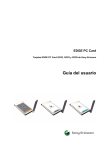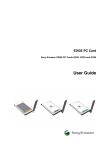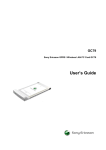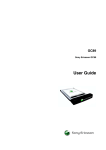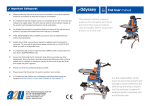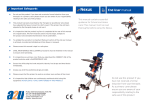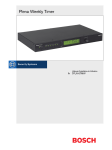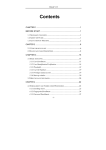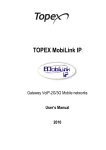Download Sony Ericsson GC75 User's Manual
Transcript
GC75 Mobilink Connect Console GC75 Sony Ericsson GPRS PC Card Modem GC75 User’s Guide 1 Content Introduction……………………………………………………………….…………….….....4 Hardware Overview………………………………………………………………………...4 Software Overview………………………………………………………….………………4 Getting Started……………………………………………………….………….…………....6 Checklist……………………………………………………………….…………………...6 System Requirements………………………………………….……………………………6 Services Available Over the Internet ………………………………………………………… 7 Installation………………………………………………………………………….………….8 GC75 Hardware Set Up……………………………………………………….………………8 Installing the Software………………………………………………………………………...9 Start Using GC75 Manager………………………………………………….…………….. 11 Safe Removal of the GC75…………………………………………………………………………11 Connect Console GPRS Screen……………………………………………………………11 Connect Console Phone Book Screen………………………………………………………11 Connect Console SMS Messages Screen……..……………………………………………14 Troubleshooting… …………………………………………………………………..……... 17 Software Errors ………………………………………………………………………..…… 17 Error Messages ……………………………………………………...……………………..17 Error Codes ……………………………………………………………………….…..……17 Additional Information………………………………………………………………..……22 Saanga Software Support Website……………………………………………..…………… 22 Important Information…………………………………………………………………..……22 Technical Specifications ………………………………………………………………..……23 Software Upgrade……….……………………………………………………………..……25 Glossary………………………………………………………….……….……………..……26 2 Sony Ericsson GPRS PC Card Modem GC75 (Version 1.0 July 2005) This manual is published by Saanga Software, without any warranty. Improvements and changes to this manual necessitated by typographical errors, inaccuracies of current information, or improvements to programs and/or equipment, may be made by Saanga Software at any time and without notice. Such changes will, however, be incorporated into new editions of this manual. This manual is copyrighted work of Saanga Software. The programs referred to herein are copyrighted and trademarked works of Saanga Software. Reproduction in whole or in part, including utilization in machines capable of reproduction or retrieval, without the express written permission of the copyright holders is prohibited. Reverse engineering is also prohibited. All other product or service names mentioned in this manual are trademarks of their respective companies. All rights reserved. Saanga Software, 2005 3 Introduction Congratulations and thank you for buying the Sony Ericsson GPRS PC Card Modem GC75.The GC75 is a triple band GSM product that enables you to communicate wirelessly from your laptop on all five continents, in over one hundred and sixty countries. As the GC75 provides wireless communications you no longer need to carry cables, telephone jack converters, chargers and batteries. The GC75 is very simple to install and use; the software provided allows you to select the best Data service available so that the GC75 is always available for data transfer. The GC75 enables your laptop PC to: ? ? ? ? ? Browse the Internet Send and receive e-mails Receive information services in real time Access files, databases and discussion groups\ Edit SIM card entries Hardware Overview The GC75 is a standard 16 bit type II PC card. The card is standard length and only the antenna protrudes outside the PC card slot. The amount of power drawn from the laptop battery is dependant upon a number of factors including status, frequency band, distance to GSM base station and number of timeslots used. See Technical Specifications on page 48 for a general guide to power consumption. Before you can start using the GC75 you need to put the hardware together. You will also need a SIM card. SIM Card When you subscribe to Mobilink, you are issued with a SIM card (Subscriber Identity Module card). The SIM contains your personal subscriber data. You need a SIM to use GC75. Software Overview Mobilink Connect Console 75 4 You can use the Mobilink Connect Console ? ? ? ? Display GC75 status information Connect to the Internet or a corporate network Manage SIM card and PC phone books Send and receive SMS messages 5 Getting Started Checklist Make sure the following items are in the box when you unpack it: ? ? ? ? ? ? Protective case for storing the GC75 and its antenna GC75 PC Card SIM tray Antenna Quick Start Guide CD-ROM The CD contains; drivers, software and documentation. System Requirements This section lists the network subscriptions, hardware and software requirements for running the GC75 PC Card. Network and Subscription The network subscription you use in conjunction with your GC75 depends on the subscriptions your network operator can provide. Contact your network operator or service provider to make sure the options you require are available. Make sure that data options are included in your subscription, as these are usually optional services. Note: Mobile operators often provide a number of connectivity options via GPRS such as WAP and Internet, so check that the Internet or VPN service you require is enabled for your subscription. General Packet Radio Service (GPRS) GPRS is a new network connection which provides “always on” mobility. The connection set up is fast and, once connected, applications may send and receive data whenever required. In today’s GPRS networks, the GC75 receives data at speeds up to 53.6 kbps and transmits at speeds up to 26.8 kbps. Short Message Service (SMS) The PC can send and receive SMS text messages using the SMS Messages screen in the Mobilink Connect Console 75. 6 Hardware You will need: ? ? ? ? A PC that has the minimum specification recommended by Microsoft to run the version of Windows® installed on it. 16 bit type II PC Card slot. Sony Ericsson GPRS PC Card Modem GC75 SIM card Software You will need: ? ? Windows ® 98SE, Me, 2000 (SP2) or XP. Mobilink Connect Console 75. Services Available Over the Internet The connect console web site contains support to facilitate easy communications and rapid information retrieval, wherever you are. It gives you access to on-line customer services, on-line user manuals, software downloads, and useful information. The address is: http://www.mobility.com.pk Saanga Software’s home page address is: http://www.saanga.net 7 Installation The Mobilink Connect Console75 CD-ROM contains the software required to operate your GC75. The software is simple to set up and operate, but before you begin you will need to make sure that the services you require are included on your SIM card subscription. Contact Mobilink and request the GPRS services. The CD-ROM contains the following software: ? ? ? ? Mobilink Connect Console 75 User Documentation On-line Help ConnectConsole text file containing the latest information about the GC75 GC75 Hardware Set Up 1. Collect your GC75 card, antenna and SIM card together. 2. Place the SIM card i n to the GC75 SIM tray and push the tray back into the GC75. Make sure the tray is closed properly before proceeding. Note: The cut corner of the SIM card must be placed into the SIM tray as demonstrated below, the SIM contacts should face upwards. 3. Connect the antenna to the GC75. 8 If the antenna is obstructing your use of the keyboard you can turn it to a horizontal position and still connect to the network. If you want to use your other PC card port remove the GC75 whilst you insert the other card. When GC75 isn't in use it is recommended that you store it in the protective carrier ox provided. The unit, especially the antenna could be damaged if it remains in PC. Installing the Software 1. Insert the GC75 Manager CD-ROM in your CD drive. After a few seconds a Connect Console splash screen is displayed. Note: If the CD-ROM does not autorun, select Start Run and type D:\Setup.bat into the Run dialog. (Where D is your CD drive.) 2. The Install Shield Wizard for Mobilink Connect Console opens; follow the Instructions on screen. When installation is complete click Finish. 3. The Setup first installs the Sony Ericsson GC75 driver and then installs Mobilink Connect Console 75. 4. Insert the GC75 PC Card. Make sure the GC75 is fully inserted. 5. Your PC recognizes that new hardware has been inserted and installs the necessary driver. This process will happen twice as two hardware drivers need to be installed. The process will take a few seconds. The New Hardware Wizard may require you to locate a specific driver file. If this happens a dialog opens, click Browse and select D:\Driver9x (where D is your CD drive) on a Windows 98 machine or D:\Driver2k (where D is your CD drive) on a Windows 2000/XP 9 machine. Select the driver file and click Open. The Hardware Wizard finishes the installation. 6. Select Programs Connect Console 75 Connect Console75 to start using your GC75. 7. The Mobilink Connect Console is ready for use. 10 Start Using Connect Console 75 1. To start Connect Console select Start Programs Connect Console 75. 2. Your SIM must be unlocked, otherwise ConnectConsole75 will display error message and exit. 3. The Connect Console75 Icon is displayed in the system tray of your PC. Safe Removal of the GC75 You must stop the ConnectConsole75 before attempting to remove it. 1. Close the Dial-up Networking Connection. 2. Exit ConnectConsole. 3. Click on the Connect Console icon. i. Select Stop Sony Ericsson GC75 Wireless Card. 4. A dialog is displayed telling you it is safe to remove the card. Important! Incorrect removal of the GC75 can damage the card. Connect Console GPRS Screen To connect to Mobilink GPRS click . Or use File –> Connect GPRS menu. Mobilink Connect Console 75 will check Signal’s strength and then connect to Mobilink GPRS. Note: While GPRS is connected, the phone book and SMS functionalities will be unavailable. To disconnect the GPRS click . If you have disconnected the GPRS using network icon in the system tray u will have to press the disconnect button again. Connect Console Phone Book Screen 11 The Connect Console Phone Book screen helps you to organize your GC75’s SIM Phone Book. A SIM Phone Book can easily become disorganized; you can use the Phone Book screen to manage your SIM Phone Book entries. You can add new numbers, edit existing numbers. 1. Click to display the Phone Book screen. Note: Your GC75 must be inserted to display this information. Phone Book Functionality To Add a Number: 1. Select Add new in the Phone Book menu or click on the toolbar or key Ctrl and N. 2. The New Phone Book Entry dialog opens. 1. 2. Enter the name and phone number. 12 3. Click OK to save the entry or Cancel to close the dialog. Note: Phone Book numbers are limited to 20 digits (including +) and names are limited to 18 alphanumeric characters. New entries are added to the next available SIM index position. To Modify a number: 1. Select the number you want to modify. 2. Select Modify... in the Phone Book menu. 3. The Edit Phone Book Entry dialog opens. 4. The fields in the dialog display the current entry’s name and number. 5. Edit the information. 6. Click OK to close the dialog and save your changes. 7. If the modified entry is in the SIM Phone Book the changes are automatically sent to the SIM. To Find Entries: 1. Select Find in the Phone Book menu. 2. The Find dialog opens. Enter the Contact Name you want to search for in the Look for field. The entry can be complete or incomplete. You can search on the First Name of the contact. 3. Click Find. The GC75 Manager searches Phone Book, when a match is found it highlights the selected contact. 13 To Delete a number: 1. Select the number that you want to delete. 2. Select Delete, from the right side of the Phone Book screen. 3. A confirmation dialog opens, click OK to delete the number. Connect Console SMS Messages Screen The Mobilink’s Connect Console SMS Messages screen enables you to view, compose, delete, reply or forward SMS messages from your GC75 to other mobile devices. Note: To use Message functionality SMS must be included in your subscription, contact your network operator for more details. 14 If a new SMS arrives when Mobilink Connect Console is open “New Message Received” is displayed on the Status bar. To Send an SMS: 1. Select Create New Message... from the Messages menu or click . 2. The New SMS dialog opens. 3. Enter the recipient’s mobile phone number in the To: field or select a number from a phone book by clicking Lookup... 4. Type your message into the Message: field. The Message field has limitation of 150 characters 5. Click Send to send the SMS or Cancel to close the dialog without sending the SMS. To Edit a Message: When you are working with a message, you can edit the text by cutting, copying and pasting. Moving Text: 1. Select the text you want to move, the text can be in another PC application. 2. Select Cut from the Edit menu or Ctrl and X on the keyboard. 3. Place the cursor where you want to insert the text and select Paste from the Edit menu or Ctrl and V on the keyboard. Note: If you want to copy text, select Copy (Ctrl and C) from the Edit menu instead of Cut (Ctrl and X). 15 Reply to an SMS: 1. Select the SMS you want to reply from the SMS Messages window. 2. From the list, select the message you want to reply to. The contents of the message are displayed in the information view. 3. Select Reply in the Messages menu. A dialogue appears. The To: field is automatically filled in and the original message is displayed in the Message: field. 4. Type your reply and click Send. To Forward an SMS: 1. Select the folder where the message is located. 2. From the list, select the message you want to forward. The contents of the message are displayed in the information view. 3. Click Forward, a dialogue opens. 4. Enter the phone number in the To: field or click Lookup... to select a number from a phone book. 5. Click Send. Delete an SMS: 1. Select the folder where the message is located. 2. From the list, select the message you want to delete. The contents of the message are displayed in the information view. 3. Select Delete from the popup menu, or press the Delete button on the side of your SMS Inbox screen. right 4. A confirmation message box opens, click OK to delete the message. 16 Troubleshooting This chapter lists some problems that you might encounter while using your GC75. Some problems require you to contact your service provider, but most of the problems you can easily correct yourself. Software Errors Grey menu options in the software applications Grey text indicates a function that is temporarily unavailable, for example due to your subscription or due to a certain setting which has not been turned on. Error Messages General Dial-Up fails Try to connect again. Error Codes Windows® 98 Error 619: The port is disconnected during dial-up Up An ISDN mode (V110 or V120) has been selected when creating a connection, but is not supported by the network. Select Analogue mode when creating the connection in the Connection Wizard. Error 630: The port was disconnected due to hardware failure during dial-up A Dial-up networking connection is already connected. Close the connected dial-up and try again. Error 645: Internal authentication error during dial-up Up Incorrect APN or CID selected for network. Modify your Dial-up Connection, see Create a Connection on page 19 for more details. Make sure that the APN file contains the name of the access point your network operator is using. See the support section on www.SonyEricsson.com site for a full list of network operator APNs. 17 Error 650: The Remote Access server is not responding during dial-up Incorrect User ID and/or password. Re enter correctly. Error 678: Computer you are dialing is not responding during dial-up Either: Service is not supported by SIM (usually for CSD/HSCSD) or the computer is not answering. 1. Check SIM settings with your service provider if necessary. 2. Make sure that the server you are dialing is OK. 3. Make sure that Analogue mode has not been selected with 57.6kbps data rate (V110 or V120 mode must be selected and supported by the network) Error 720: No PPP control protocols Configured during dial-up The service is not supported by the SIM, usually appears when you are trying to connect to GPRS Internet. Contact service provider to enable GPRS Internet access on SIM card Windows® 2000 Error 619: The port is disconnected during dial-up Error 678: Computer you are dialing is not responding during dial-up An ISDN mode (V110 or V120) has been selected when creating a connection, but is not supported by the network Select Analogue mode when creating the connection in the Connection Wizard. Either: Service is not supported by SIM (usually for CSD/HSCSD) or the computer is not answering. 1. Check SIM settings with your service provider if necessary. 2. 3. Make sure that the server you are dialing is OK. Make sure that Analogue mode has not been selected with 57.6 kbps data rate (V110 or V120 mode must be selected and supported by the network). Error 691: Access denied, user name and password incorrect on the domain during dial-up The domain name entry is incorrect. Correct the domain name entry or delete if not required. Error 718: The card was unable to This error indicates a PPP conversation started, but it was terminated because the remote server did not respond 18 dial during dial-up within an appropriate time. This can be caused by poor line quality or a problem with the server (ISP). This error can occur when your modem has connected to the ISP and has sent a username and password, but there is no response from the server. Wait a few minutes and try again All Windows® Operating Systems Error 734: The PPP link control protocol was terminated during dial-up The APN entry is incorrect, the signal is weak or the connection is lost whilst dialing. See the support section on www.mobility.com.pk site for a full list of network operator APNs. Error 678: Computer you are dialing is not responding during dial-up Either: Service is not supported by SIM (usually for CSD/HSCSD) or the computer is not answering. Check SIM settings with your service provider if necessary. Make sure that the server you are dialing is OK. If you are unsure which speed to choose from the Speed tab, start with Analogue 9600, and check to see if it works. Once your connection works on Analog, you can try the V110/V120 settings to see if faster speeds are available. V110/V120 also connects faster than analog. When roaming you may need to repeat this procedure to adapt your settings to the capability of the local network operator. Connection Failed or Activation Failed. Please contact your Service Provider. No specific reason for failure is available. Wait a few minutes and try again. If you continue to get this error check your connection settings or call your service provider for help. Connection Failed. Invalid APN. Please check and enter the APN again. The APN entry is incorrect, the signal is weak or the connection is lost whilst dialing. See the support section on www.SonyEricsson.com site for a list of network operator APNs or contact your service provider. Connection Failed. Invalid User Name or Password. Please check and enter the User Name and/or Password in your connection profile. Choose to modify your connection in the Connection Wizard. Go to the User ID screen and re enter the User Name and Password given to you by your service provider. If you were not supplied with a User Name and Password leave the fields blank. Contact your service provider if you continue to have problems. Connection Failed. Invalid Profile. Please check and re-enter your connection profile information, and Your service provider doesn't recognize you. Check the setting you have entered to create your connection. If you still get the error contact your service provider and check you have GPRS Internet enabled on your subscription and 19 try again. If the problem continues please contact your Service Provider. then setting you should enter to create a connection. Disconnected from Network You have been disconnected from the network. Wait a few minutes and try again. If the problem persists contact your service provider. Connection failed. Temporary Network problem. Please try again. If the problem continues please contact your Service Provider. This error indicates a PPP conversation started, but it was terminated because the remote server did not respond within an appropriate time. This can be caused by poor line quality or a problem with the server (ISP). This error can occur when your modem has connected to the ISP and has sent a username and password, but there is no response from the server. Wait a few minutes and try again. Connection Failed. Not authorized to access network. Please contact your Service Provider. Your service provider doesn't think your authorized to access their network. Check the setting you have entered to create your connection. If you still get the error contact your service provider and check your subscription. Connection Failed. SIM is invalid for GPRS service. Please contact your Service Provider. Contact your service provider and request the GPRS Internet subscription is activated for your SIM. Connection Failed. Access to network not allowed. Please contact your Service Provider. Your service provider is not allowing you to access their network. Check the setting you have entered to create your connection. If you still get the error contact your service provider and check your subscription. Connection Failed. Roaming not allowed. Please contact your Service Provider. Contact your service provider to get your roaming activated. Connection Failed. Please try again. If the problem continues please contact your Service Provider. You couldn’t connect to the network. Wait a few minutes and try again. If the problem persists contact your service provider. Connection Failed. Service not supported. Please try again. If the problem continues please contact your Service Your service provider is not allowing you to access their network. Contact your service provider and check you have the subscriptions required activated for your SIM. 20 Provider. Connection Failed. Network Problem. Please try again. If the problem continues please contact your Service Provider. You couldn’t connect to the network. Wait a few minutes and try again. If the problem persists contact your service provider. 21 Additional Information Saanga Software Support Web Site At http://www.mobility.com.pk you can find help and tips in a few clicks. The support site gives you access to: ? ? ? ? the latest software updates tips on how to use your GC75 efficiently function guides additional help Important Information Please read this information before using your GC75. Recommendations ? ? ? ? ? ? ? ? Always treat your product with care and keep it in a clean and dust-free place. Do not expose your product to liquid, moisture or humidity. Do not expose your product to extreme high or low temperatures. Do not expose your product to open flames or lit tobacco products. Do not drop, throw or try to bend your product. Do not paint your product. Do not attempt to disassemble your product. Only Sony Ericsson authorized personnel should perform service. Do not remove the SIM Antenna Only use an antenna that has been specifically designed by Sony Ericsson for your GC75.Use of unauthorized or modified antennas could damage your GC75. Children Do NOT allow children to play with your GC75. They could hurt themselves or others, or could accidentally damage the GC75. Your GC75 may contain small parts that could be detached and create a choking hazard. Disposing of the Product Your GC75 should not be placed in municipal waste. Please check local regulations for disposal of electronic products. 22 Electronic Devices Most modern electronic equipment, for example equipment in hospitals and cars, is shielded from RF energy. However, certain electronic equipment is not, therefore: Do not use your GC75 near medical equipment without requesting permission. The GC75 may affect the operation of some implanted cardiac pacemakers and other medically implanted equipment. Pacemaker patients should be aware that the use of a GC75 very close to a pacemaker might cause the device to malfunction. Avoid placing the GC75 over the pacemaker. If a minimum distance of 15 cm (6'' inches) is kept between the GC75 and the pacemaker, the risk of interference is limited. If you have any reason to suspect that interference is taking place, immediately turn off your GC75. Contact your cardiologist for more information. If you use any other personal medical device, consult the manufacturer of your device to determine if it is adequately shielded from external RF energy. Turn your GC75 off in any facility where posted notices so require. Aircraft You MUST remove your GC75 before boarding any aircraft. To prevent interference with communication systems and abide by the law, you must not use your GC75 while the plane is in the air. Do not use it on the ground without permission from the crew. Blasting Areas Turn off your GC75 when in a blasting area or in areas posted turn off two-way radio to avoid interfering with blasting operations. Construction crews often use remote control RF devices to set off explosives. Explosive Atmospheres Turn off your GC75 when in any area with a potentially explosive atmosphere. It is rare, but your GC75 could generate sparks. Sparks in such areas could cause an explosion or fire resulting in bodily injury or even death. Areas with a potentially explosive atmosphere are often, but not always, clearly marked. They include fuelling areas, below deck on boats, fuel or chemical transfer or storage facilities, and areas where the air contains chemicals or particles, such as grain, dust, or metal powders. Do not transport or store flammable gas, liquid, or explosives in the compartment of your vehicle, which contains your GC75 and accessories. Inserting and removing the SIM card – precautions against electrostatic discharge (ESD) Do not touch the SIM card connectors. As a precaution, always make sure that the GC75 is already in your hand before you insert or remove the SIM card. Technical Specifications 23 Product name System GSM 1800 GSM 1900 Services supported Speech services are not Supported SIM Card SIM Lock supported GC75 E-GSM 900 Type Number 6130201-BV CSD, HSCSD, GPRS, SMS, Fax Small plug-in card Exterior Description Size PC Card Weight Battery Antenna 85.6 mm long x 54.0mm wide x 5.0 mm thick Type II, 16 bit 38g including antenna, excluding SIM card Powered via the PC card slot i.e. uses laptop battery 50 ohm interface; Antenna supplied Ambient Temperatures Operating Storage 10 to 55 degrees C -20 to 65 degrees C Electrical Characteristics Supported Voltages Nominal Operating Voltage Standby Current Standby Power Consumption (no PDP context active) Idle current (9/2 multiframe paging period) (PDP context active) Idle power (9/2 multiframe) Maximum Current 3.3V ± 10% 3.6V 4.2mA 13.86mW 5.0mA/7.6mA 800mA 2W Operating System Support Supported Operating Systems Minimum PC Specification Microsoft Windows 98 (SE) Microsoft Windows Me Microsoft Windows 2000 (SP2) Microsoft Windows ? XP Processor size as recommended by Microsoft for the version of 24 Windows ® in use 30 MB free disk space Current Consumption Standby Idle Transmitting (Max) Switched on but not making a call and not attached to GPRS Current Consumption < 5 mA Connected to the Internet using GPRS, in an ‘always connected’ state with no data flowing Current Consumption < 8 mA Maximum power output, GSM900 Current Consumption 800 mA Software Upgrade Via secure internet download the upgraded version from www.mobility.com.pk . 25 Glossary Bearer GPRS General Packet Radio Services. Path over which data flows. Specifically in CSD and HSCSD, the type of telephony link from the GSM network to the server - V PSTN or ISDN. bps Bits per second - rate of data flow. COM Port Defines a serial/RS -232 port within the Windows ® environment. May be physical (COM1 port on the rear of the PC) or virtual (COM5 port communicating with a PC card modem) CS Circuit Switched. Connection from A to B which has a fixed bandwidth and is maintained over a period of time, for example a voice telephone call. CS-1 to CS-4 Coding Scheme. Determines the data rate per timeslot in GPRS. GSM Global System for Mobile Communications. GSM is the world’s most widely-used digital mobile phone system, now operating in over 160 countries around the world. GSM 900 The GSM system family includes GSM 900, GSM 1800 and GSM 1900. There are different phases of rollout for the GSM system and GSM phones are either phase 1 or phase 2 compliant. GSM 1800 Also known as DCS 1800 or PCN, this is a GSM digital network working on a frequency of 1800 MHz. It is used in Europe and Asia-Pacific. GSM 1900 CSD Circuit Switched Data. CSD is a GSM service providing a CS data connection at a rate of 9.6 or 14.4 kbps. Also known as PCS. Refers to a GSM system running in the 1900MHz band. Used in the USA and Canada, for instance. DUN HSCSD Dial-Up Networking. High Speed Circuit Switched Data. e-GSM HTML Extended GSM. New frequencies specified by the European Radio Communications Committee (ERC) for GSM use when additional spectrum is needed (Network-dependent). It allows operators to HyperText Markup Language. HTTP 26 transmit and receive just outside GSM’s core 900 frequency band. This extension gives increased network capability. ETSI HyperText Transfer Protocol. European Telecommunications Standards Institute. www.etsi.org GGSN ISP Internet Service Provider. Gateway GPRS Support Node LAN Kilobits per second - rate of data flow ISDN Integrated Services Digital Network. Can provide circuit-switched data connections in multiples of 64 kbps. kbps PSTN Local Area Network. ME Mobile Equipment. Public Switched Telephone Network, for example ordinary analogue phone line for speech and/or computer modem. MO RADIUS Mobile Origination. For example, an SMS message sent from a mobile terminal. Remote Access Dial-In Service. Facility at the ISP or corporation to manage remote data connections. RX MMI Man-Machine Interface. Receive SC Service Centre (for SMS). MS Service Provider Mobile Station. MT A company that provides services and subscriptions to GC75 users. Mobile Termination. SIM card PC Subscriber Identity Module card – a card that must be inserted in any GSM-based mobile terminal. It contains subscriber details, security information and memory for a personal directory of numbers. The card can be a small plug-in type or credit card-sized, but both types have the same functions. The GC75 uses the small plug-in card. Personal Computer. PCS Personal Communications Services, often used to describe GSM1900 networks. PC Card SMS A card having physical and electrical characteristics specified by PCMCIA providing extra functionality when inserted into a laptop PC. Typical examples are modems and network cards. Type refers to the thickness of the card. The GC75 is type II. PCMCIA Personal Computer Memory Card International Association – defines specifications for PC Cards. Short Message Service. Allows messages of up to 160 characters to be sent and received via the network operator's message centre to a GC75. TCP/IP Transmission Control Protocol/Internet Protocol. TCP/IPv4 27 www.pcmcia.org PDP Packet Data Protocol. Phone book A memory in the SIM card where phone numbers can be stored and accessed by name or position. TLS TCP/IP Version 4. Most widely implemented form of TCP/IP today having a 4 byte address format such as 212.161.127.136. TE Terminal Equipment. Generic term for GSM terminals such as phones and PC cards. Terminal Adaptor Generic term for the equipment terminating a digital comms line such as an ISDN2 line. The GC75 is a Terminal Adaptor since it interfaces to GSM digital data services. Transport Layer Security. Used by Web browsers, for example. TX Transmit Type II Refers to thickness of a PC Card as defined in The specification from PCMCIA. URL Uniform Resource Locator. USSD Unstructured Supplementary Services Data. Narrow-band GSM data service. For example entering *79*1234# might return the stock price for stock 1234. V.110 ETSI standard for data over an ISDN circuit. V.120 ETSI standard for data over an ISDN circuit. VPN Virtual Private Network. WWW World Wide Web. XML Extensible Markup Language 28




























